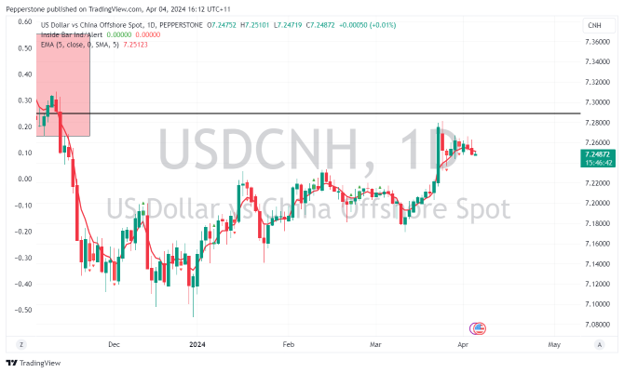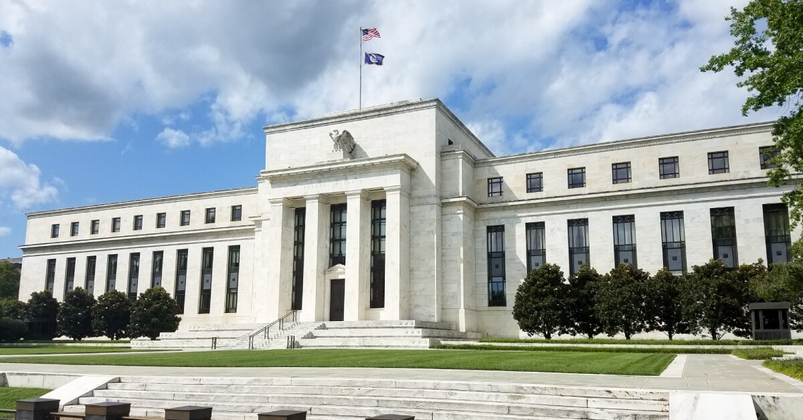- English
- 中文版
From March 12th to March 22nd, the USDCNH exchange rate surged from approximately 7.18 to around 7.28. Particularly noteworthy is the sharp increase of over 500 points observed on March 22nd, indicating a significant depreciation of CNH.
Despite a slight retreat in the exchange rate since then, it continues to hover above 7.2, representing a deviation of about 1.5% from the midpoint rate set by the People's Bank of China (PBoC) at 7.0950.

Previously, the threshold of 7.2 has been regarded by China as a critical level prompting potential intervention in the foreign exchange market. However, it appears that the monetary authorities have tacitly accepted a moderate depreciation of CNH to some extent.
With the Chinese economy still in the process of recovering from the pandemic and facing lingering challenges in the real estate market and interest rate pressures, a cautiously loose foreign exchange policy might be advantageous.
Reasons for the CNH depreciation
Domestically, recent economic indicators have shown some positive trends, such as March's manufacturing PMI entering expansion territory for the first time in nearly six months, alongside an expansion in foreign trade. The release of data exceeding expectations has bolstered risk sentiment in the market, reflected in the volatile upward movements of the CN50 and CSI300 indices.
However, it must be acknowledged that challenges persist, including property market concerns, subdued household consumption, and deflationary pressures, making it somewhat challenging to bolster investor confidence in the short term.
Additionally, stable sentiment in the domestic stock market and a scarcity of USD in the swap market, leading to increased intervention costs, have somewhat dampened the motivation for monetary authorities to adjust interest rates.
Externally, as a major exporting nation, China is highly sensitive to changes in purchasing power in other economies. Europe, Japan, and Australia have witnessed their manufacturing PMIs hovering around contraction territory or showing limited expansion since mid-2022, indicating a potential shrinkage in global manufacturing. This poses concerns for China's exports.
Furthermore, the interest rate differential between China and the US is a significant factor influencing the direction of CNH. Recent speeches by Fed officials have exhibited a slightly more hawkish tone compared to before, suggesting expectations of the Fed maintaining high-interest rates for a longer period. This has supported the performance of the USD. In contrast, China has implemented a series of loose monetary policies since last year, resulting in a divergence in interest rate policies that currently renders CNH relatively less attractive.
Overall, despite signs of economic recovery in China, persistent internal challenges and the unlikely short-term narrowing of the interest rate differential between China and the US predominate as bearish factors for CNH.
How long will the situation last?
The PBoC has been delicately balancing the interventions: maintaining a policy loose enough to stimulate growth while moderately tightening to prevent capital outflows and market panic.
Continued CNH depreciation would erode consumer and investor confidence, contradicting long-term goals of promoting economic growth. Additionally, a weakened CNH could potentially impact stock market performance and reduce the attractiveness of government bonds. Therefore, the central bank is expected to intervene.
Historically, during CNH depreciation, Chinese authorities have not only strengthened rate fixings but also implemented measures such as capital controls and state-owned bank USD sales. Although USDCNH has retraced from its recent highs in late March, sustaining a downward trend would prove challenging if market expectations of Fed rate cuts are postponed.
Nonetheless, the specific trajectory of USDCNH will hinge on whether monetary authorities maintain a steadfast belief in stability below 7.2 or seek a new equilibrium.
The April Politburo meeting warrants attention. However, considering that GDP growth exceeded the official target of 5% last year and is likely to increase in the second quarter due to base effects, the likelihood of additional policy easing at this Politburo meeting is diminished. In other words, CNH is expected to receive some support.
What next?
The PBoC's fixing measures effectively restored the exchange rate to the target range. However, the market's lack of sensitivity to the central bank's liquidity injections and the persistent internal economic challenges mentioned above have not significantly improved.
In return, China is actively striving to boost economic performance, such as lifting tariffs on Australian wines to stimulate imports and relaxing the loan ratio for vehicle purchases to bolster domestic consumption. Additionally, President Xi's meeting with representatives of the US business community last week, coupled with relaxed cross-border data transfer regulations, underscores China's continued openness to foreign investment and businesses. These measures are conducive to fundamentally boosting demand, increasing confidence in capital inflows into China, and indirectly supporting CNH's performance.
With the current external environment relatively bleak, I believe the PBoC will implement appropriate monetary easing measures, such as further reserve requirement ratio cuts or government bond purchases.
In conclusion, considering China's current situation and the international economic environment, gradually increasing the USDCNH fixing range appears to be a more favorable option. However, fundamentally restoring the economy and enhancing international competitiveness are reasonable ways to maintain the long-term stability of CNH values.
Related articles
The material provided here has not been prepared in accordance with legal requirements designed to promote the independence of investment research and as such is considered to be a marketing communication. Whilst it is not subject to any prohibition on dealing ahead of the dissemination of investment research we will not seek to take any advantage before providing it to our clients.
Pepperstone doesn’t represent that the material provided here is accurate, current or complete, and therefore shouldn’t be relied upon as such. The information, whether from a third party or not, isn’t to be considered as a recommendation; or an offer to buy or sell; or the solicitation of an offer to buy or sell any security, financial product or instrument; or to participate in any particular trading strategy. It does not take into account readers’ financial situation or investment objectives. We advise any readers of this content to seek their own advice. Without the approval of Pepperstone, reproduction or redistribution of this information isn’t permitted.
.jpg)



